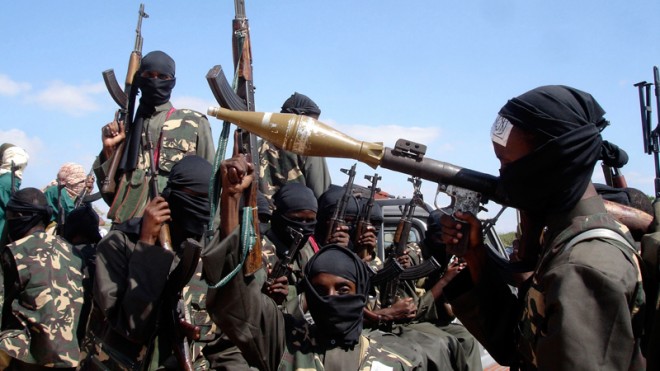US strike may have killed Somali extremist group leader

In this Dec. 8, 2008 file photo, armed al-shabab fighters on pickup trucks prepare to travel into the city, just outside Mogadishu, in Somalia. U.S. military forces targeted the Islamic extremist al-Shabab network in an operation Monday, Sept. 1, 2014 in Somalia, the Pentagon said. (AP Photo/Farah Abdi Warsameh, File)
MOGADISHU, Somalia — U.S. airstrikes in Somalia may have killed the leader of the Islamic extremist group al-Shabab, with a militant commander saying Tuesday that he was in a car that was struck and that six people died.
The leader, Ahmed Abdi Godane, has no heir apparent. If he has been killed, it would be a “significant blow” to al-Shabab’s organization and abilities, said U.S. Navy Rear Adm. John Kirby, a Pentagon spokesman, who confirmed the strikes targeting Godane.
But Godane’s death could also lead the group to ditch its association with al-Qaida and align itself with the Islamic State group in Syria and Iraq, analysts said. Al-Shabab gained international notoriety a year ago this month when it attacked the upscale Westgate Mall in Nairobi, Kenya, killing at least 67 people.
Godane was in one of two vehicles hit by the U.S. military strikes Monday night, said Abu Mohammed, an al-Shabab commander and spokesman. He said six militants were killed, but would not say if Godane was among them. The two vehicles were heading toward the coastal town of Barawe, al-Shabab’s main base, Mohammed told The Associated Press.
The U.S. strikes hit Godane after he left a meeting of the group’s top leaders, said a senior Somali intelligence official. Intelligence indicated Godane “might have been killed along with other militants,” said the Somali official, who spoke on condition of anonymity since he was not authorized to speak to the press.
Article continues after this advertisementKirby, the Pentagon spokesman, said the U.S. launched the operation based on “actionable” intelligence, and the strikes “hit what we were aiming at.” But commanders were waiting to determine the outcome of the attack.
Article continues after this advertisementThe strikes on an encampment and a vehicle were conducted by special operations forces using manned and unmanned aircraft, according to Kirby. They struck using several hellfire missiles and precision-guided munitions.
A witness in Somalia described ground-shaking explosions. Somali government and African Union forces heading to a town in the district heard what sounded like an “earthquake,” said the governor of Somalia’s Lower Shabelle region, Abdiqadir Mohamed Nor.
The attack took place 105 miles (170 kilometers) south of Mogadishu in a forested area where al-Shabab trains its fighters, he said.
Godane, also known as Mukhtar Abu Zubeyr, is al-Shabab’s spiritual leader under whose direction the Somali militants forged an alliance with al-Qaida. In 2012 the U.S. offered a reward of up to $7 million for information leading to his arrest.
If Godane has been killed, the leadership upheaval could bring al-Shabab to break away from al-Qaida and instead pledge allegiance to the Islamic State group in Syria and Iraq, according to two security experts.
Godane has no obvious successor and there are reports of a rift within al-Shabab over which global terror group to align with, said Matt Bryden, the head of Sahan Research in Nairobi. A struggle for power seems likely, he said.
“Advanced splintering seems like a probable outcome,” terrorism analyst J.M. Berger said. “If Shabab ends up exiting al-Qaida, there will be global implications for that … but it’s hard to say right now which way that will go.”
Godane, 37, was publicly named as leader of al-Shabab in December 2007 and has since exercised command responsibility for the group’s operations across Somalia, according to the National Counterterrorism Center.
Last year he was said to be in a feud with foreign militants, including an American jihadi from Alabama, Omar Hammami, who accused al-Shabab leaders of enjoying extravagant lifestyles with taxes collected from Somali residents. Hammami was killed last September following months on the run after falling out with Godane.
After Monday’s airstrikes, masked Islamic militants in the area arrested dozens of residents they suspected of spying for the U.S. and searched nearby homes, a resident said.
“Everyone is being detained,” said Mohamed Ali, who lives in Sablale district. “They even searched nearby jungles and stopped the nomads transporting milk and grass to the towns for questioning.”
The U.S. has carried out several airstrikes in Somalia in recent years. A missile strike in January killed a high-ranking intelligence officer for al-Shabab, and last October a vehicle carrying senior members of the group was hit in a U.S. attack that killed al-Shabab’s top explosives expert.
The latest U.S. action comes after Somalia’s government forces regained control of a high-security prison in the capital. Seven heavily armed suspected al-Shabab members attempted on Sunday to free other extremists held there.
Al Shabab is now mostly active in Somalia’s rural regions after being ousted from the capital by African Union forces in 2011.
Somali military officials last week launched a military operation to oust al-Shabab from its last remaining bases in the southern parts of Somalia. On Saturday the militants withdrew from the town of Bulomarer, located about 110 kilometers (70 miles) south of Mogadishu, after hours of fighting.
Al-Shabab attacked the mall in Nairobi last year to punish Kenya for sending troops into Somalia against the extremists. Godane said at the time that the mall attack was carried out in retaliation for the West’s support for Kenya’s Somalia intervention and the “interest of their oil companies.”